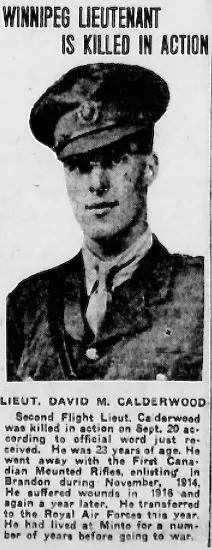Calderwood, David Miller (Second-Lieutenant)
Killed in Action 1918-September-20


Birth Date: 1893-January-31
Born:
Parents: John & Isabella McDonald Calderwood.
Spouse:
Home:
Enlistment:
Enlistment Date: unkown date
Service
RAF
Unit
20 (FB) Sqn- Squadron (RAF)
Facta Non Verba Deeds not words
Base
France
Rank
Second-Lieutenant
Position
gunner-observer
Service Numbers
F.2 (Bristol) serial: E2158

The Shuttleworth Collection's Bristol F.2B Fighter
The Bristol F.2 Fighter was a British two-seat biplane fighter and reconnaissance aircraft of the First World War developed by Frank Barnwell at the Bristol Aeroplane Company. It is often simply called the Bristol Fighter, other popular names include the "Brisfit" or "Biff".
Although the type was intended initially as a replacement for the pre-war Royal Aircraft Factory B.E.2c reconnaissance aircraft, the new Rolls-Royce Falcon V12 engine gave it the performance of a two-seat fighter.
Despite a disastrous start to its career, the definitive F.2B version proved to be a manoeuvrable aircraft that was able to hold its own against single-seat fighters; its robust design ensured that it remained in military service into the 1930s. Some surplus aircraft were registered for civilian use and civilian versions proved popular.
Perhaps one of the best known flying aces to use the type was Canadian Andrew Edward McKeever, and his regular observer L.F. Powell.[18] By the end of 1917 McKeever had accumulated 30 shoot-downs of enemy aircraft, while Powell had achieved eight aerial kills, while operating the Fighter. McKeever later became a flying instructor stationed in England before becoming the commanding officer of No. 1 Squadron of the newly formed Royal Canadian Air Force (RCAF), where he continued to use the Fighter as his personal aircraft, which was later transferred to Canada Wikipedia